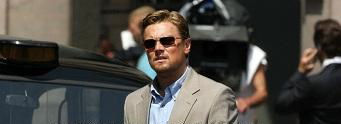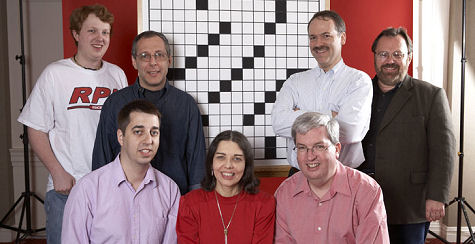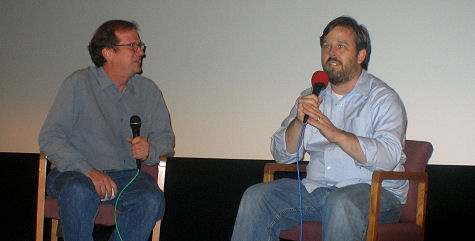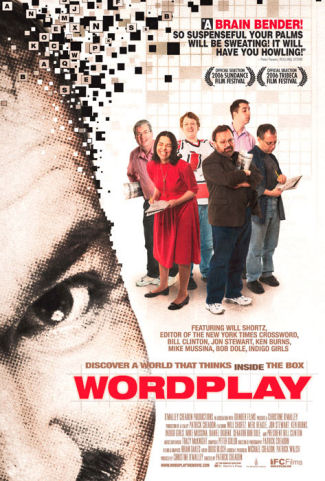The L.A. Film Festival kicks off tomorrow night, and is it me (a definite possibility) or am I detecting an extra measure of vitality…some kind of exceptional on-it factor? The special events, parties, discussions and film selections feel almost Seattle-ish….perhaps even better than that. Here are 19 initial picks, and I’m sure there are five or ten other films and events I shouldn’t be overlooking: (1) Julie Anderson‘s Mr. Conservative: Goldwater on Goldwater (6.24, 2 pm, Majestic Crest — 6.30, 7 pm, UCLA James Bridges — 7.2, 5:30, Laemmle’s Sunset); (2) Jauretsi Saizarbitoria and Emilia Menocal‘s East of Havana (6.25, 9:45 pm, Mann Festival — 6.29, 10 pm, Majestic Crest — 7.1, 4:45 pm, Laemmle Sunset); (3) Bill Couturie‘s Boffo! Tinseltown’s Bombs and Blockbusters (6.28, 7:15 pm, Mann Festival); (4) Kelly Reichardt ‘s Old Joy (6.23, 5 pm, Italian Cultural Institute); (5) “The Nature of Film Criticism: Neil LaBute and Kenneth Turan” (6.23, Armand Hammer, free); (6) Neil Marshall‘s The Descent (6.23, 8:30 pm, John Anson Ford Amphitheatre); (7) Discussion panel titled “Unshown Cinema: Inside the World of The Films That Got Away” (6.25, Armand Hammer, free); (8) Stanley Kubrick‘s Dr. Strangelove or: How I Learned to Stop Worrying and Love the Bomb (6.25, 9:30 pm, UCLA James Bridges Theater); (9) “Conversation with Richard Linklater” (6.25, 7 pm, Italian Cultural Institute); (10) Nikolaus Geyrhalter ‘s Our Daily Bread (6.27, 9:30 pm, UCLA James Bridges Theater — 7.1, 4:45 pm, Landmark’s Regent); (11) Bradley Beesley, Julianna Brannum and James Payne‘s The Creek Runs Red (6.27, 7:15 pm, Landmark’s Regent — 6.30, 5:15 pm, Italian Cultural Institute — 7.2, 3:15 pm, Laemmle Laemmle Sunset 5); (12) Chris Gorak‘s Right At Your Door (6.28, 9:45 pm, Mann Festival Theatre — 6.30, 4:30 pm, Mann Festival); (13) Fabian Bielinsky‘s The Aura (6.28, 9:30 pm, Landmark’s Regent); (14) Richard linklater’s A Scanner Darkly (6.29, 8:30 pm, John Anson Ford Amphitheatre); (15) So Yong Kim‘s In Between Days (6.29, 9:30 pm, Landmark’s Regent — 7.1, 7 pm, Landmark’s Regent); (16) Jean Luc Godard‘s vMasculine Feminine (6.29, 9:45 pm, UCLA James Bridges); (17) Gil Kenan‘s Monster House (6.30, 8:30 pm, John Anson Ford Amphitheatre); (18) Lisandro Alonso ‘s Los Muertos (6.30, 9:30 pm, UCLA James Bridges Theater); (19) “Conversation with James Ellroy” (6.26, 9:45 pm, Italian Cultural Institute).
Day: June 21, 2006
Harry and Brandon
Harry Knowles chit-chatting with Brandon Routh…keep it light, keep it fanboyish, keep it friendly.
Goldstein vs. Finke
“If you’re going to run anonymous criticism of someone’s story” — i.e, the one written last Monday by L.A. Times columnist Patrick Goldstein — “[by] saying ‘these articles never interview black execs, even in confidence — they always go after high-level talent to comment…’ you could at least call me or email me and ask if that was actually true in my case,” Goldstein has written Deadline Hollywood columnist Nikki Finke in an e-mail. “If you had called, I would have told you this: Of course, I interviewed plenty of black executives. What this person doesn’t seem to realize is that no black exec currently employed at a studio feels safe enough in their job to openly criticize their bosses about they dismal hiring record. They are only willing to say it off the record. And unlike the rest of the world, I√ɬ¢√¢‚Äö¬¨√¢‚Äû¬¢m very old-fashioned — I don√ɬ¢√¢‚Äö¬¨√¢‚Äû¬¢t run anonymous quotes from anybody. I feel people have a right to know who’s doing the talking. I think it’s also unfair to imply that Spike and Singleton don√ɬ¢√¢‚Äö¬¨√¢‚Äû¬¢t hire enough black staff, since I go on tons of movie sets and they are the two guys who always have a predominantly African-American crew, something you almost never see in white, white Hollywood. But mostly, if you√ɬ¢√¢‚Äö¬¨√¢‚Äû¬¢re going to allow someone to comment on my column, and whether I did the right kind of interviews, you owe me a fair chance to respond.” Finke then responds to Goldstein’s response, et. al.
Desperation Move
This isn’t going to make that much of a difference. The die is cast, the digital fix is in, and Old Media is on a slippery-ass slope. The decision by L.A. Times management to hire away longtime Hollywood Reporter veteran Lynne Segall to try and turn things around paints a pretty clear picture of what’s been going down and how scared they all are.
“Blood Diamonds,” Mandela and De Beers
HE’s who-gives-a-shit? scanner is officially switched on this afternoon regarding Ed Zwick‘s Blood Diamond (Warner Bros., probably Nov./Dec.). It feels to me like an on-the-nose moral outrage piece…a sticky-wicket neg-head thing.

Do you want to see a dramatically grandiose Ed Zwick melodrama about a mercenary (Leonardo DiCaprio) and a fisherman (Djimon Hounsou) mucking about during the Sierra Leone civil wars of the ’90s? An era when rebels seized mines to sell “blood diamonds” to buy arms as they murdered and mutilated thousands of innocent men, women and children? (You do?) I’m not following the thread but somehow the resistance levels are even higher with this report from L.A. Times reporter Elizabeth Snead that Sitrick and Company, L.A.s highest-profile damage-control publicists, have been hired by De Beers, a bigtime South African supplier of rough diamonds, to counterspin the negative image of their industry delivered by Zwick’s film, and that Sittrick, in turn, will be using former South Africa president and anti-apartheid crusader Nelson Mandela as a spokesperson. √ɬ¢√¢‚Äö¬¨√Ö‚ÄúMandela is going to say that all that stuff seen in the film is in the past, that there are no more conflict diamonds in circulation and that the diamond industry is economically good for South Africa,√ɬ¢√¢‚Äö¬¨√Ǭù a source has told Snead. √ɬ¢√¢‚Äö¬¨√Ö‚ÄúAnd who in their right mind is going to argue with Nelson Mandela?”
Late to “Wordplay”
Late to Wordplay
I’d been hearing good things about Patrick Creadon’s Wordplay since it played at last January’s Sundance Film Festival, but missing the subsequent screenings. So I leapt at the chance to see it last night (i.e., Tuesday) at Santa Monica’s Aero as part of Pete Hammond’s KCET screening series.
I expected something smart, engaging, amusing (Jon Stewart being one of the talking heads), but I wasn’t expecting a Mensa-style “heart” movie about an extended family. That’s what Wordplay is, and why it ought to keep playing and playing in urban blue-state areas, and — who knows? — maybe all over.

Wordplay gang: (l. to r. foreground) Trip Payne, Ellen Ripstein, Al Sanders; (l. to r. background) Tyler Hinman, Jon Delfin, Will Shortz, Merl Reagle
I never thought I could get so caught up in the lives of intellectual game-players and puzzle fanatics, but there’s an emotional current to their existence that’s just as real and embracable as anything you’ve seen or felt on The Waltons or Malcom in the Middle or any other hokey family TV series.
I feel nothing but loathing for the family-relationship pablum in those two Cheaper by the Dozen films, but Wordplay is the real deal — a movie about a family of engaging eccentrics whose brains cross paths every morning via The N.Y. Times crossword puzzle, and who bond with each other every year in a very warm and fraternal way at an annual Crossword Players tournament in Stamford, Connecticut.
< ?php include ('/home/hollyw9/public_html/wired'); ?>
Wordplay started out as a profile of N.Y. Times crossword page editor Will Shortz, but gradually expanded into a group portrait of six hardcore types — crossword constructor Merl Reagle, pudgy not-quiter Al Sanders, congenial former champion Ellen Ripstein, super-brilliant Trip Payne, a 20 year-old whiz kid named Tyler Hinman, and a bespectacled Tin Pan Alley piano player named Jon Delfin.
The Philadelphia Inquirer‘s Carrie Rickey calls them “word nerds.”
I’ve always felt so intimidated by the N.Y. Times crossword puzzle. Some of the words and clues are so arcane and obscure. Until I saw Wordplay I was totally unaware that there’s a kind of grass that grows in the wide-open midwest areas called “redtop.” But now I feel like becoming a crossword addict regardless. The movie is that infectious.

KCET screening series host Pete Hammond (l.) and Wordplay director Patrick Creadon after last night’s screening at Santa Monica’s Aero/American Cinematheque theatre — 6.20.06, 8:55 pm.
Wordplay sure is fantastic publicity for the New York Times and longtime editor Shortz.
Celebrity guests besides Stewart include the charming Bill Clinton (who’s constantly grinning and filling out a crossword puzzle as he talks with Creadon), Bob Dole (who finally consented to be in the film when Clinton called and urged him to do so), documentarian Ken Burns, the Indigo Girls, and Yankee hurler Mike Mussina.
Everyone in the film worships the daily Times puzzle as the “gold standard.” No other puzzles from any source are even mentioned except for USA Today‘s, and when it comes it’s a put-down.
Wordplay ends, predictably, with the March 2005 championship tournament. The suspense kicks in when the final three contestants go up against each other in front of an audience, writing their answers on large-sized posterboard crossword grids. You can figure out who’s probably going to win, but you’re never 100% sure.

Skeptics should understand that while Wordplay is about some very smart people with phenomenal vocabularies, it’s not a snob movie at all. The Wordplay Seven are good people with containable egos who care about crossword puzzles like others care about baseball or basketball or going to church.
There’s some fairly terrific graphic work by Brian Oakes that brings the viewer into various crossword games that are played throughout the film, creating a play-along excitement that most audiences will find extremely cool.
I suggested during last night’s q & a with Creadon that a smarty-pants reality TV series could be created out of the day-to-day lives of the Wordplay family. It could crescendo each week — on Sunday night, naturally — with the six or seven principals jumping into the Times Sunday crossword puzzle.
IFC Films opened Wordplay in Manhattan last weekend on four screens and took in $32,847 for an $8200 average. The film goes out nationwide this Friday (6.23).
Superman 3D Reactions
Superman Returns director Bryan Singer was “thrilled” with the IMAX 3D version at a screening last Friday, says a 6.20 L.A. Times story by Geoff Boucher. He adds, however, that “others attending the screening were put off by a distracting blurring effect that crops up when the action crosses the screen at high speed.” Bullshit — I noticed a very slight blurring around the edges, but that’s par for the course with IMAX 3D. (I won’t see the final version until next Tuesday.) Boucher admits that “some sequences — such as that plummeting plane — have an undeniable gee-whiz factor.” After the screening, Singer “talked about adding some unique footage to the IMAX version — restoring some footage to the early part of the film (it showed Superman on the gutted husk of Krypton) that might be especially dramatic with the visual effect.” There’s only about 20 minutes worth of 3D footage in the IMAX version of Superman Returns, so how will viewers know when the 3D scenes are on? “Pretty much when Clark Kent takes his glasses off,” Singer said, “you put yours on.”
Styles of Shooting
There’s a doc by Jon Fauer called Cinematographer Style showing at the Academy next Tuesday (6.27) that, according to the copy on the invitation, “takes audiences into the hearts and minds of 110 renowned cinematographers, offering a rare glimpse into the art of visual storytelling and the universal language of cinematography.” In other words, it covers the same turf as Todd McCarthy and Arnold Glassman‘s Vision of Light, which is generally regarded as the definitive (so far) doc about the art of cinematography. Has anyone seen the Fauer doc? I’m suspicious of anything or anyone intending to explore the art of cinematography that uses the word “style” in its title. Does this mean if you were making a doc about the most venal dictators of all time (Hitler, Stalin, Pol Pot, etc.), you could conceivably call it Dictator’s Style?
Koehler’s Will
Variety critic Robert Koehler swears that Randy Walker and Jennifer Shainin‘s Apart From That, which played at Cinevegas and the Seattle Film Festival, is “the best American film I’ve seen this year.” Here’s his review, “which gets in some but hardly all of my thoughts,” Koehler says. “If you like Richard Ford‘s and Raymond Carver‘s fiction and what I’m now sensing is a new radical American cinema characterized by films like Old Joy, then you’ll probably like Apart From That. Then again, you may not. It would have done very well in competition in either Un Certain Regard or the Quinzaine, but for whatever reason Cannes turned it down. (It was ready for Sundance, but the filmmakers didn’t submit it. Had it been shown in Park City, Apart From That would be famous by now.) For me, it’s the U.S. find of the year, along with In Between Days.” Koehler, by the way, is hosting an L.A. Film Festival discussion on Sunday, 6.25, at 5 pm at Westwood’s Armand Hammer Museum called “Unshown Cinema: Inside the World of The Films That Got Away.” “YOU ARE BEING DEPRIVED OF THE OPPORTUNITY TO SEE HUNDREDS OF GREAT MOVIES EACH YEAR,” the copy reads, “and you probably don’t even know it! Of the over 2,000 movies produced annually, the average Los Angeles filmgoer has access to fewer than 400 titles. In a market supposedly glutted with new product, why are there still so many great films being made both in the US and abroad that you have no opportunity to see?” The panelists besides Koehler will be the legendary, frizzy-haired, never-say-die director Monte Hellman, Greg Laemmle of Laemmle Theatres, Warner Independent’s Paul Federbush, L.A. Weekly film critic Scott Foundas, and bespectacled publicist Ziggy Kozlowski of Block-Korenbrot. Koehler warns that “your ability to see unconventional movies and visions that challenge the norm that is at stake.” It is fine and good to challenge the norm, but you don’t have to be particularly talented or inspired to do that. What finally counts isn’t challenging the norm, per se, but challenging it in a way that turns people’s heads around, knock their socks off and makes them go “whoa!” Is this something that Apart From That or In-Between Days accomplish?
Thomson on Herrmann
The late composer Bernard Herrmann “made life easier for good films,” says David Thomson in a recent Guardian piece. Many Alfred Hitchcock films in particular — Vertigo, Psycho, North by Northwest (the final act of this film is nearly a Hermann symphony in itself), The Man Who Knew Too Much — as well as Citizen Kane, Taxi Driver, The Day The Earth Stood Still, et. al. This may sound insignificant, but I feel Hermann’s most delicious accomplishments are his incidental mood pieces in thrillers, in particular the ones that seem to say “be careful…bad stuff could quite easily happen to this character.” Here are three sublime samples from that closing portion of North by Northwest…they take you right into the film. Thomson apparently got on the Herrmann topic because the San Francisco Symphony (under Michael Tilson Thomas) will perform some Hermann compositions next July (or were they performed last July?…can’t quite follow). Herrmann would probably be perplexed, Thomson feels. “A tribute? Thank you, very nice, but no cigar. Why are you playing the music without the movie? Don’t you get it — they are married. They want to be in bed together.”
Slacker Town
This is a good Nikki Finke satire piece because it’s grounded in fact. Hollywood is Slacker Town. Almost everyone works long hours — twelve-hour days are fairly standard — but too many in the upper echelons overcompensate by taking extended vacations (“working” or otherwise) that eat up huge chunks of the calendar. Finke’s piece was triggered by news that “some Hollywood types [are] already leaving town for the July 4th holiday.” I’m guessing that the big vacation-takers are those with school-age or younger kids, and I can relate to that. But at the end of the day (especially these days) I subscribe to words that David Mamet wrote 20 years ago for an episode of Hill Street Blues: “I went to sleep dreaming life is beauty — I woke the next day knowing life is duty.” Life is short, we’re all strutting and fretting our hour upon the stage, and either you get it or you don’t. Better creative work is done on less-full stomachs and less vacation money to draw upon, but of course (and this is the bottom line) most of the folks in this town aren’t in it for the creative highs but the money saunas. How many people in this town would do what they do if the bucks weren’t quite as flush? How many are in it for the work itself rather than the creamy compensatory comforts? You know Jack Black would be Jack Black no matter what, but could the same be said of Gail Berman or Brad Grey or Ron Meyer or a hundred others I could name? If Hollywood were to suddenly become socialist and adopt the salary plan that the London magazine Time Out had around 1980, which was that everyone earned the exact same salary, you would see an exodus like nothing since Moses led the Jews out of Egypt. (For the record, HE’s work day is 15 to 16 hours if you count screenings. Longer if you count DVD-watching, primarily a relaxation thing but one with occasional work-related aspects.)
